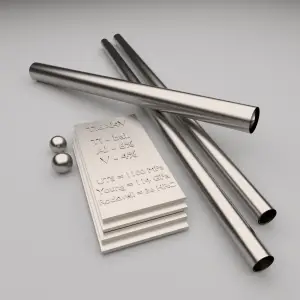 Titanium alloys are metals that contain a mixture of titanium and other chemical elements. Such alloys have very high tensile strength and toughness (even at extreme temperatures). They are light in weight, have extraordinary corrosion resistance and the ability to withstand extreme temperatures.
Titanium alloys are metals that contain a mixture of titanium and other chemical elements. Such alloys have very high tensile strength and toughness (even at extreme temperatures). They are light in weight, have extraordinary corrosion resistance and the ability to withstand extreme temperatures.
Titanium Alpha Alloys
Titanium exists in two crystallographic forms. At room temperature, unalloyed (commercially pure) titanium has a hexagonal close-packed (hcp) crystal structure referred to as alpha (α) phase. When the temperature of pure titanium reaches 885 °C (called the β transus temperature of titanium), the crystal structure changes to a bcc structure known as beta (β) phase. Alloying elements either raise or lower the temperature for the α-to- β transformation, so alloying elements in titanium are classified as either α stabilizers or β stabilizers. For example, vanadium, niobium, and molybdenum decrease the α-to-β transformation temperature and promote the formation of the β phase.
- Alpha Alloys. Alpha alloys contain elements such as aluminum and tin and are preferred for high temperature applications because of their superior creep characteristics.. These α-stabilizing elements work by either inhibiting change in the phase transformation temperature or by causing it to increase. The absence of a ductile-to-brittle transition, a feature of β alloys, makes α alloys suitable for cryogenic applications. On the other hand, cannot be strengthened by heat treatment because alpha is the stable phase and thus they are not so strength as beta alloys.
Grade 1 Titanium
Commercially pure titanium grade 1 is the most ductile and softest titanium alloy. It is a good solution for cold forming and corrosive environments. It possesses the greatest formability, excellent corrosion resistance and high impact toughness. Due to its formability, it is commonly available as titanium plate and tubing. These include:
- Chemical processing
- Chlorate manufacturing
- Architecture
- Medical industry
- Marine industry
- Automotive parts
- Airframe structure
We hope, this article, Titanium Alpha Alloys, helps you. If so, give us a like in the sidebar. Main purpose of this website is to help the public to learn some interesting and important information about materials and their properties.